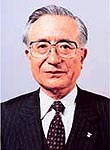
Chairman of the Board of Councillors, Keidanren
Counselor, Tokyo Electric Power Company
 |
Shoh Nasu Chairman of the Board of Councillors, Keidanren Counselor, Tokyo Electric Power Company |
The city of Cologne hosted the summit of the Group of Eight nations earlier this year and Japanese newspapers and television often reported the streets of this old German city. As usual many of these pictures featured the well-known cathedral of the city. As you may know, this magnificent edifice symbolizes architectural technologies and styles accumulated over 600 years from the start of its construction in the 13th century to its completion in the present form in the 19th century. These pictures offered to me, as member of the business community having spent much of the time in a private company, an opportunity of considering as what value the accumulation of persistent endeavors by many people in the history of economy would be handed down to posterity.
Some optimistic views on Japanese economy are beginning to appear on the press these days. But many continue to assess that the current deep economic recession in Japan was caused by the "collapse of the bubble economy." Considering their argument, which ascribes the nation's misfortune solely to the "collapse of the bubble economy," I regret to note that the Japanese people as a whole still lack the perception that what was wrong was the "bubble economy" itself. In other words, I would like to point out that there is a discrepancy in assessing historical facts. In the days of the bubble economy, mental desolation amid affluence, especially a speculative craze, mammonism under the coat of competition, and lack of consideration to the defeated and the weak, apparently grew more and more serious with the expansion of values in various aspects of the economy. And very few in Japan predicted the collapse of the bubble economy or criticized the bubble economy itself in those days.
Now, towards the end of the 20th century, I believe we have to review these recent trends once again with modesty. Indeed, this is the time for us to think about the function of a safety brake system on the whole Japanese society, including our forerunners who have influenced the history of the nation for the last 100 years. This is an occasion to stress again that the key to the solution of this issue is the "revival of the public spirit among private citizens," which I have proposed in the same page of this Monthly Keidanren three years ago. This means that we should act not in a self-centered manner but with more careful consideration given to our partners and other people around us.
Referring to the behavior and manner of young Sumo wrestlers, a great Yokozuna (Grand champion) who has been dead for years said, "they do not look their opponents in the eye, so they are always very clumsy in standing up to wrestle and often repeat calling out 'matta' - not ready." The wrestlers' knack of simultaneously standing up to fight with each other is the key to a breathtaking bout that captivates the audience and, I believe, this is a very good example of the public spirit.